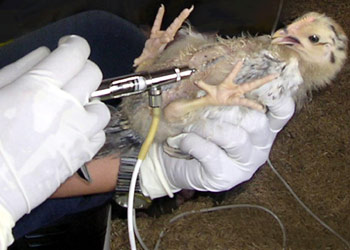
Vaccinate poultry before finishing.Document photos .
Wait for a suspected case of hospitalization, taking a test sample, treatment and reporting as a process that the health sector is taking. This process is too passive, the Director of Ho Chi Minh City Pasteur Institute Nguyen Thi Kim Tien commented at the meeting to discuss measures to prevent bird flu on August 16 in Ho Chi Minh City.
According to Ms. Tien, with the above method, the health sector must follow the epidemic so the prevention is not really effective. And so is not supervised because "monitoring is action".
Ms. Tien also said that the veterinary sector is not open when cooperating with the health sector in fighting diseases.
"Every time the medical side asks for data about the epidemic, the veterinary side will not provide it. It always says that the data is a secret that cannot be said. This makes it difficult for medical personnel to gather data. In the epidemic surveillance research, by the time veterinary data was published, the disease had spread widely, "said Ms. Tien.

Vaccinate poultry before finishing.Document photos .
According to Ms. Tien, district and provincial health workers must contact directly with the local veterinary staff to be able to handle it immediately and immediately stop the spread. The health sector works as a supervisor but is always in a state . waiting for a report from the hospital before proceeding to review. If health workers go to the commune and take care of the hamlet to understand the reality and the possibility of being infected by the people, the prevention will be more positive.
In the prevention of avian influenza, the veterinary industry is original, but "the original is not solid" because the force at the facility is too thin. Each commune has only one veterinarian, so when there are epidemics, people want to report and do not know to tell anyone; Veterinary staff could not detect, did not monitor in place at the place of symptoms or disease outbreaks. This is why the upline is so tight but prevention is not really effective. For example, in 2005, Ben Tre province reported a case of H5N1 infection but did not know in which district the commune .
Ms. Tien said that each commune must have at least 5 veterinarians and a force of about 25 collaborators to effectively monitor diseases in small livestock families. In fact, up to now, cases of H5N1 infection and death are small livestock farmers. And concentrated farms have not found any cases.
However, veterinarian Nguyen Thuy Hong of Ho Chi Minh City Department of Animal Health said that the supervision of paravets is not effective because of lack of funding for environmental sanitation, investigation and treatment . Paravets are not properly trained. In some provinces, grassroots veterinarians under the management of the agricultural department should have difficulty receiving direct guidance from the industry .
Therefore, there are many cases where veterinarians do wrong principles such as seeing the symptoms of epidemics as a rush to request the cancellation of poultry flocks; while the sample should have been taken, the result will be confirmed.
Avian influenza has been present in 59 countries;10 countries have patients with 263 cases;138 people died.In Vietnam alone, there are 42 deaths out of 93 cases.In this year alone, Vietnam only had 2 suspected cases but the test results were negative for H5N1.
Serological tests have not detected the possibility of H5N1 virus spreading from person to person.Sample testing of all veterinarians vaccinating poultry is also negative.
Vietnam has 2 research projects on the preparation of H5N1 vaccine in humans.Particularly, the research topic of producing vaccines with vero cell culture technology has been done initially by Ho Chi Minh City Paster Institute.
My Lan